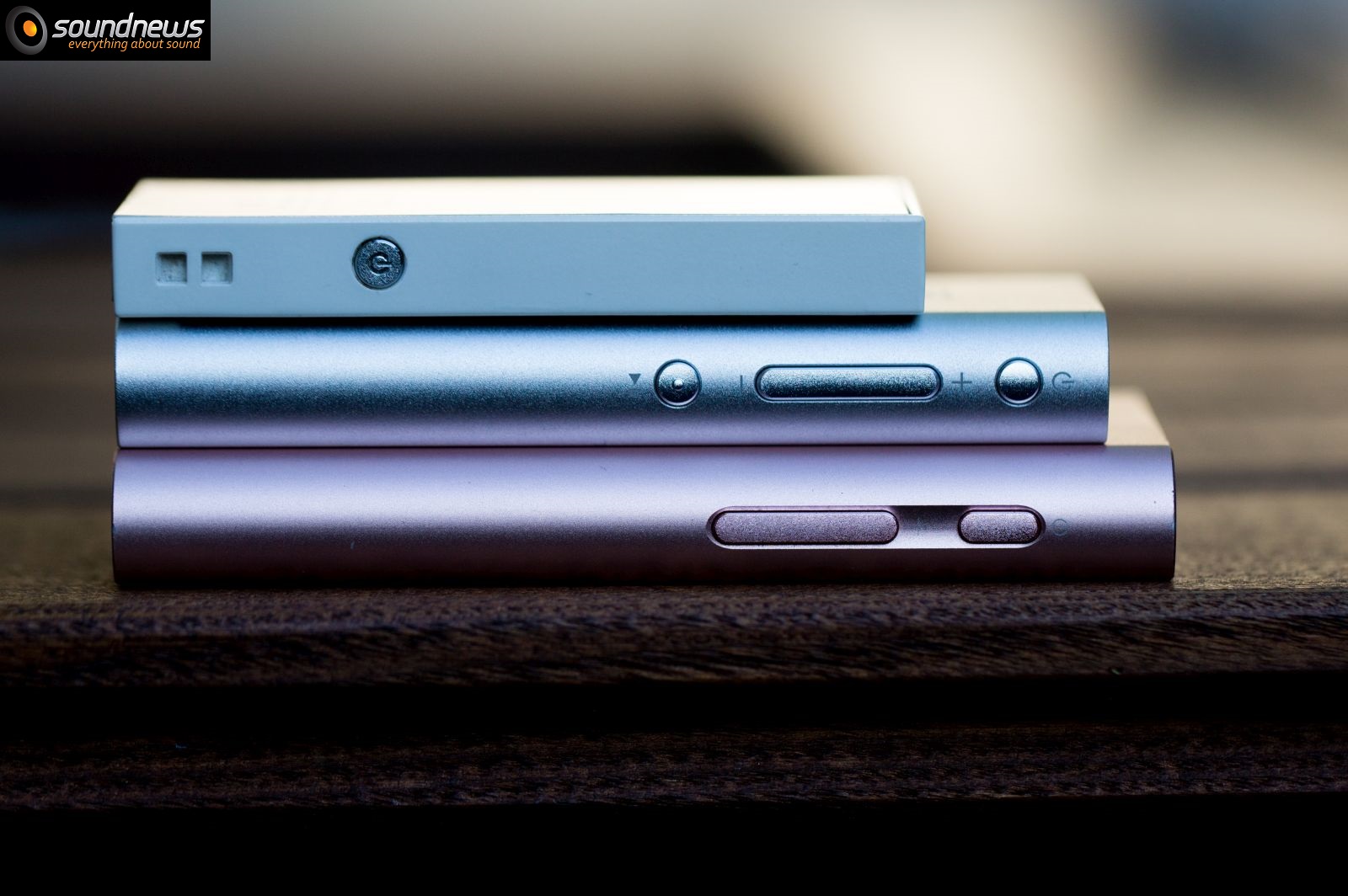
Disclaimer : The FiiO M3K was sent to us free of charge in exchange for our honest review. We thank FiiO for that!
At the beginning of 2016 I had the pleasure of testing the smallest Hi-Res capable DAP on the market, the FiiO M3. I was pretty enthusiastic about it as the sound was exactly what I was expecting, it had great battery life, however the plasticky case and the sloppy and hard to follow UI ruined the final experience for me. What could be an extraordinary and a very recommended DAP turned into an ordinary device due to not taking very seriously the important aspects that define a portable DAP: first physical impressions, first SQ impressions and of course the easy to use interface.
The brand new M3K promises to solve all the problems raised by us
Let’s get the job done and check if the manufacturer kept his word.

Build quality & Design
Without a doubt in the development cycle of M3K a big emphasis was put on design and at finding the right selection of materials in its construction.
This time around the case is entirely made of anodized aluminum and the front panel is made out of tempered glass for a superior scratch and shock resistance.
From my point of view M3K looks much more elegant, simple and modern than its predecessor.
Physically it is smaller than X1-II but a bit bigger than M3, here’s a photo of the three siblings.
M3K together with other 2 devices represent the smallest Hi-Res DAPs we have tested that I consider to be truly portable and pocketable comparing to other heavy weight category of DAPs we have tested in the past.
M3K feels great in the hand and can be easily operated one handed due to the touch panel on the front and to all buttons conveniently moved to the left.
Besides the On/Off, R/F and Play/Pause buttons there is a standard 3.5 mm phone jack on the bottom, a microSD card slot and a microUSB jack for data transfer and charging.
M3K doesn’t have internal memory, music can be stored only on the microSD cards, theoretically up to 2 Tb cards are supported, we used a 128 GB Sandisk Ultra with great success.

The sexy rotary volume wheel found on the more expensive devices has been abandoned and changed with 2 simple volume buttons for two reasons: very limited internal space and production costs. After all, M3K is an entry-level DAP who does not want to disturb your budget too much.
The IPS screen has a diagonal of 2″ and a 320 x 240 pixels resolution, it looks clear and bright, the colors are alive, the view angle is better than I expected. One important thing for me is that the album covers are natively displayed as a square, a small thing that was missing and bothered me on both the old M3 and on the X1-II.
I also enjoyed the small details (new in the FiiO portfolio) that sometimes makes the difference between a good device and a refined one, such as the Hi-Res logo is no longer just a sticker glued on the back of the device but it is laser engraved directly on the aluminum surface. Another interesting thing is that during the playback of a lossless file in the lower right corner the SQ logo (for sound quality) will be displayed, the HR logo appears if a Hi-Res file is being played, the DSD logo for playing a DSD file and if a simple lossy file (such as mp3) is played no other logo will be displayed. This way I will know in advance the quality of the track being played without checking it in the „view track info”.
For now, there is nothing to reproach, it looks good, it can be easily used by one hand and above all the build quality plunged way ahead compared to the unit it replaces.

Under the Hood
The chosen CPU is the Ingenic X1000/E clocked at 1 Ghz that will handle the UI and all its functions and due to a simple OS, this CPU is more than enough. M3K responds fast, boots almost instantly, clearly faster than M3, than X1-II and much faster than any Android-based DAPs of any manufacturer.
The UI itself runs smoothly if a PCM lossy or lossless (16 or 24 bit) is being played … however on DSD material it is another story, where I felt it responds slower to commands and generally the UI slows down quite a bit. If you own a vast collection of DSD material I think it would be a wiser choice moving to a better DAP that moves faster on such files as FiiO M7.
At the heart of audio decoding the AK4376A is doing a really fine job as it is much more advanced than the one found on the M3, it is even more advanced than Ti PCM5242 found on X1-II and on X3-III.
AK4376A is part of a newer generation of digital to analog converters specially made for portable audio devices. Besides the actual audio decoding this chip also incorporates the final stage of headphone amplification without the need of additional op-amps, an ideal choice for having a clearer and purer sound.

Connected to a PC/Mac the little M3K can work as an USB DAC as well that will be instantly recognized by the OS. USB connection is Asynchronous type for a better jitter immunity.
At the development of M3K, the dedicated line out, digital out and Bluetooth emitter were dropped in exchange of a new feature – a digital voice recorder, on the upper part of the case a small mesh like hole can be seen that represents the microphone. M3K can record in a lossy and lossless format.
By far the best part is the battery life; in standby mode it will work up to 38 days and when listening to music at normal volume levels it will rock your ears for 24 hours straight!
This is the most impressive battery life I’ve seen on a Hi-Res DAP followed by that of M7 with autonomy of 20 hours.
Internal headphone amp is part of the AK4376A SoC and therefore does not impress as much as the FiiO X Series players do. M3K offers up to 42mW in 16 Ω and 25 mW in 32 Ω. As a reference with the FH5 IEMs from FiiO I can’t go more than 35 volume (from max 60).

Graphical User Interface (GUI)
New UI is much friendlier compared to the old M3, it’s simple and intuitive.
You can browse by folder (I used this the most) and by categories such as by artist, album, genre and by playlists. Custom playlists can be created as well which I always do.
The most important audio setting can be found in Play Settings, I see that there aren’t any gain settings.
Few shortcuts are present as well without touching the screen, and the Play/Pause button can be reprogrammed to do another function, I do recommend checking the manual for all extra things that can be done.
To this moment the GUI (together with the one of M7) represent a big step forward, it is extremely user friendly and intuitive, I need exactly 2 touches to play a song after the device boots up.
This is an interesting one, let’s check what it can really do.

Audio Performance
Firstly, M3K was tested solo in a portable setup and as an external DAC in a desktop setup and later on it was compared to M3 and to X1-II. I used it with hybrid IEMs as well as with portable dynamic headphones.
I had an attempt to use it with Sennheiser HD660S but without adding a proper portable amp in the acoustic chain I couldn’t drive them properly.
Let’s be serious, M3K was not designed to drive desktop class headphone and as such cannot do such things.
Instead the FiiO FH5 hybrids were driven excellent, volume was about in the 30 to 35 position (from maximum of 60) and on Sennheiser Momentum 2.0 (the over-ear ones) volume position was on 45 from 60.
Power reserve is there, it drives more than decently any portable headphones, including balanced armature-based IEMs.
Oh, by the way M3K with BA IEMs is among the very few DAPs that can boast with a very low level of hiss or any type of noise. The background noise is inaudible on ultra-sensitive FH5! The old M3 as well as the X1-II cannot match it in this regard.
I do get that FH5 will be probably be overkill for this device but it is nice to know that M3K is completely free of noise, I personally know few guys that want a small DAP to use it with BA IEMs in the gym or when jogging.
Frequency response is quite linear, without massive gaps or rises.

The biggest improvement towards older M3 is that the sound is no longer hysterical, cramped and too laid back.
M3K sounds more open, smoother and much more detailed.
Overall the sound breathes well, it doesn’t have a well spread and deep soundstage, however it doesn’t sound claustrophobic (as it was with the old M3).
There is a decent amount of air between the notes, the mushiness present on the mobile phones is nowhere to be found, a sign that the Cross Talk is much better than that of a mobile phone.
Soundstage is not incredibly large but it is wide enough to listen to an orchestra and feel on stage with your favorite artists. Acoustic barriers as notes hitting an imaginary wall can still be heard. Overall sounds are heard mostly around my head and not just inside my head as mobile phones do.
The sound impresses more with its depth than with its width or height.
There is a short gap until the next note is heard, during which time the outline of each musical note can be appreciated more.
Probably the most important aspect of the little M3K is that it sounds clean and detailed.
Few weeks ago, I was shocked of how good a simple Bluetooth receiver can sound; I’m speaking about the BTR3 that sounded almost like a desktop setup. I have the same feeling with M3K, these two are very alike. Not surprisingly because both devices are using the same DAC chips.

On M3K the sound goes towards a linear experience, a very honest sound that doesn’t want to interfere in the freq.response. In this regard M3K is very different to M3 and even to X1-II.
M3K together with M7 are showing the new direction that FiiO is embracing and by that, I mean an airy and crystal-clear sound signature.
As a result, M3K doesn’t offer the warmness and tenderness that older generation of FiiO devices had (X1-II, X3-III), the emphasis is not put on bass and midrange presence but more on the sonic experience as a whole.
It is interesting that M3K mates really well with majority of earphones regarding of sonic signature it carries. Sound coloration together with M3K is minimal and most of the times you’ll hear the mastering coloration or of the headphones themselves.
I will not analyze the frequency response divided into bass, midrange and treble because there is a very good tonal balance between the three and none of them stands out.
The high level of detail retrieval and the airy presentation will always lead to good dynamics and to a faster transient response.
M3K again shows that older FiiO sound signature is long gone, the slower and romantic presentation is no more and it is being replaced with a faster transient response. Every note sounds more agile creating a better impact on the eardrums at the same time having a better control without overflowing the neighboring frequencies.
In this sense M3K surpasses the performance of more expensive DAPs such as X1 II and X3-III.
Slowly but surely, I understand that FiiO transits to a new sound and somehow to a new beginning, the new M3K, M7 and very soon M9 go shoulder to shoulder in the same direction.

Comparisons
Old school M3 VS New School M3K

From the first touches I realize that M3K is part of a higher class.
Absolutely everything is improved: the build quality, the fit and finish, the interface is much faster and simpler, the battery life and last but not least the sound quality.
M3 sounds crowded and artificial somehow. M3 gives a feeling that it is struggling too much to sound good, it doesn’t have a good flow also. M3 is not binding the notes in a natural way, that smoothness present on higher quality DAPs is nowhere to be found. For a simple portable DAP M3 does a good job but if you have any audiophile standards then M3 is completely out of the question.
M3K sound smoother like notes are tied with silk thread, the transition from bass to midrange and later to the treble is felt more natural and more pleasant to the ears. Sound is more expansive, deeper and much clearer. M3K is also more detailed and will extract more information from your favorite tunes.
On Hi-Res material it is even a bigger difference, M3K simply spreads its wings on such files.
It is clear that M3K can already be classified as a DAP towards audiophiles, it has everything it needs: sound was above expectations and battery can easily last for a week if I listen for 3 hours a day.

Red pill M3K VS Blue pill X1-II

X1 is a bit heavier, a bit bigger and navigation is a bit cumbersome, I prefer the up and down scrolling on the M3K compared to the circular scroll a la iPod. X1 battery life is weaker, it can be used with wireless headphones that will not work on M3K, instead M3k has a voice recorder built-in.
X1-II is also a bit more expensive and build quality is almost identical between the two.
Sound wise X1 its even smoother; it has a very special liquidity on slow music, sounds more melancholic and will grab my feeling more often.
On the other hand, M3K sounds much faster, has quicker decay of notes and overall is more agile in its presentation. Between the two M3K is a faster guy, the sound has higher dynamics on M3K than on X1 and will impress more on rhythmic and modern music.

Transparency is slightly higher on M3K as well as the detail retrieval.
M3K is a bit more linear somehow without being clinical, boring and uninteresting, as a comparison X1 is emphasizing the midrange and bass response. Anything you listen to on X1 you will always hear the bass and midrange first, on M3K no particular frequency is being outlined, M3K is closer to reference in my opinion.
X1-II sounds more extended on width, and a little airier, there is a greater void between the notes, while with M3K I can better appreciate the outline of each note, musical notes are clearly more defined.
M3K sounds closer to the listener, without being cramped.
For my music preferences M3K is more impressive, but I realize that on slower tunes X1-II will win every time.
Pick your poison!

Conclusions
For some reasons M3K exceeded my expectations, it is small and truly portable, its strong like a brick and has a very attractive price.
It doesn’t have a radio and doesn’t work with Bluetooth headphones, but the sound that I’ve heard easily rivals the more expensive DAPs out there. I decided to not compare it with its bigger brother X3-III because it could upset the owners of said device, I will only mention that the M3K can challenge X3-III any time if only the single ended headphone output (3.5mm) is taken into consideration and not the balanced one.
M3K outright shattered the old M3 who has been in KO since the beginning of the article. Although I felt M3 was not really worthy of the FiiO name, M3K is worthy of its name!
PROS:
- Modern design, solid build quality
- Neutral sound without being boring or clinical
- Has a good tonal balance between musicality and acoustic qualities
- Presence of a USB DAC and voice recorder
- Total lack of hiss or background noise
- Drives portable headphones with ease
- Deep and well spread soundstage
- Mega attractive price point
CONS:
- Lack of a balanced output, dedicated line-out and of the Bluetooth
- Limited power output for desktop headphones
ASSOCIATED EQUIPMENT:
- DAPs: FiiO M3, M3K, X1-II, X3-III
- IEMs: FiiO FH5, F9 PRO, Shure SE846
- Portable headphones: Sennheiser Momentum M2.0
- Desktop headphones: Sennheiser HD660S
- Portable headphone amp: Headamp Pico Power







